Battle for Figs: Victory
/32 Comments/in Fruit, Pests/by Lee ReichSome History
I don’t know the score over the years, but this year’s victory is mine. The battles have been with scale insects, both armored scales and their cousins, mealybugs (but rarely both in the same year), on my greenhouse fig plants.
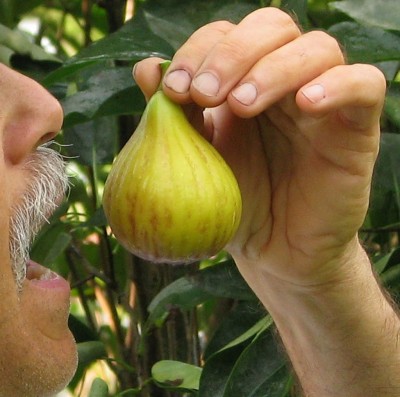
Those fig plants are planted in the ground in a minimally heated greenhouse, where winter temperatures can sink to about 35°F. The oldest of these plants have trunks 8 inches in diameter. They thrived for years without any pest problems, scale of otherwise. A few years ago, the insects made their appearance, sometimes ruining almost the whole crop.
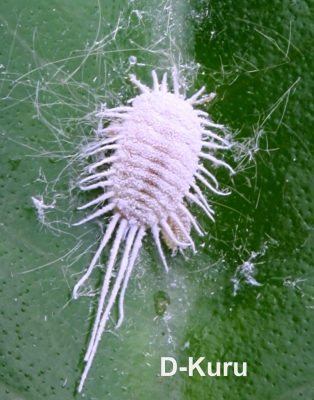
Over the years I fought them in various ways. One year it was spraying the dormant plants with alcohol. Another year it was, more aggressively, scrubbing trunks and stems of dormant plants with a toothbrush dipped in alcohol. Ants herd and protect scale insects, so another year I fenced the ants off the plants with a band of masking tape coated with forever (almost) sticky Tangletrap around the trunk of each plant.
An expensive but short-lived success was the two releases of the predatory ladybird beetle Cryptolaemus montrouzieri and the parasitoid wasp Anagyrus pseudococci.
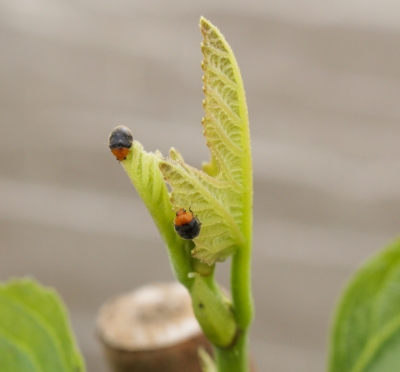
Mealybug destroyer
These biocontrol helpers ended up valuing each fig at about a dollar, still worth it. I screened all openings in the greenhouse, hoping to perennialize them inside. (It was not effective.)
Battle Plan, Done
So this year I tried a multipronged approach.
The biggest change was, rather than growing the figs as bushy trees, training them as espaliers. Espalier is the training of plants to an orderly, usually two-dimensional form both for beauty and, in the case of fruit plants, for good production of high quality fruit. For my figs, an additional benefit would be that each plant would only have one point of contact — its trunk — with the ground. IA band of masking tape coated with Tangletrap would be a roadblock on the ant highway. (Plus the look of the plants always elicits a “Wow” from visitors.)
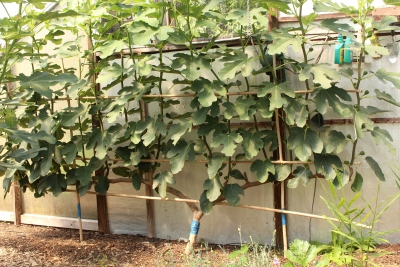
The fig plant growing near the greenhouse endwall has a short trunk that, after rising to about 18 inches from ground level, bifurcates into two, self-supporting horizontal arms extending parallel to the wall in opposite directions. At the head of each of the south beds, a fig tree is planted each of whose trunk is terminated by just a single, self-supporting, horizontal arm reaching down the bed to the sidewall. With just a trunk and one or two arms, thoroughly scrubbing down the dormant plant with alcohol is a relatively quick job. Quick enough to prevent 2 or 3 scrubbing before plants resume growth in early spring from becoming tedious.
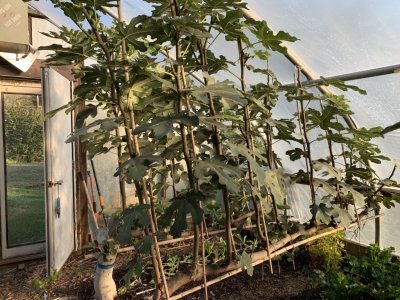
Another nice feature of this training system is that pruning the plants at the end of the season is a no-brainer. Vertical shoots that rise up from the horizontal arms are thinned to keep neighboring shoots 8 inches apart and helped along in their vertical growth by being trained to pieces of bamboo attached to the greenhouse roof. (Yes, an ant could walk up the wall and across the roof of the greenhouse and then down the bamboo to get at the plants but they are either not that smart or energetic; it hasn’t happened.)
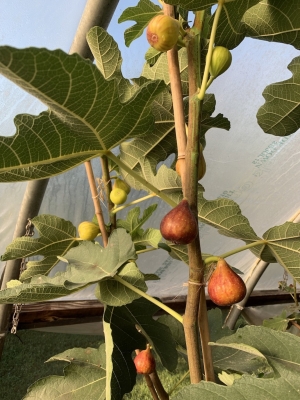
A little later in the early part of the greenhouse growing season I gave the plants some dowsings with neem oil. I’m not sure how effective the neem component is but “horticultural oil” itself is effective in fighting off scale insects.
A ring of cinnamon around the base of each plant provided further disincentive to the ants, who will not cross a cinnamon line. The cinnamon and the Tangletrap did need renewal once per season.
As new fig shoots soared skyward near the greenhouse roof, I used a pole pruner to prune out the top of the growing shoot. Side branches, of course, then grew, and I periodically had to to hack them back also.
Uh Oh, But All Still Good
Everything was copacetic and we were harvesting figs, which formed along the vertical stems at the juncture of almost every leaf. Then, in late August I noticed some mealybugs on one plant. Time for Cryptolaemus montrouzieri again. I released them in early September and we were back in business, harvesting large handfuls of three different varieties of delciously sweet figs — San Piero, Brown Turkey, and Rabbi Samuel — daily.
And then, just today, I noticed armored scales on the plants, and a few ants! I’m not sure how the ants are getting onto the plants, but one possible “benefit” of the armored scales is hardly any mealybugs. Perhaps they can’t coexist.

All the measures I took against mealybugs should also be effective against the armored scales, except for the Cryptolaemus montrouzieri. Their predator Aphytis melinus, also known as the Golden Chalcid, has been effective against armored scales.
I’m not taking action. With less sunlight and cooler temperatures the figs trees have slowed down, running out of new stems on which to hang fruit. No matter; it’s been a good season of fresh figs.
Colorful, Sometimes Tasty, Ground
/7 Comments/in Flowers, Soil, Vegetables/by Lee ReichLurid Ground
Lurid, violet flowers have sprouted in the wood chip mulch beneath my row of dwarf pear trees. The flowers are autumn crocuses, the first part of the two-part flowery show that takes place each autumn in that piece of ground.
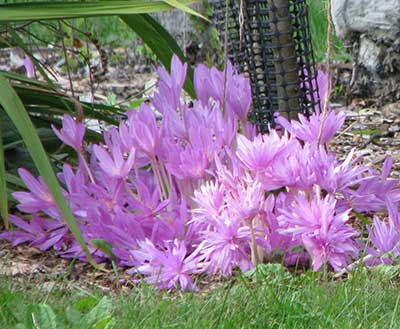
The second part of that flowery show, soon to follow, will be autumn crocuses. “But,” you exclaim, “autumn crocuses were the first part of the show!” Let me explain.
This first show is from a flower called autumn crocus but which is botanically a Colchicum species. It’s not really a crocus, not even related. Colchicum flowers resemble true crocus flowers, on steroids. The second show will be from true crocuses (that is, Crocus species) that happen to bloom in autumn. The Crocus autumn crocuses are dainty and in colors like our spring crocuses.
What’s really unique about the colchicum flowers, and what makes them so striking, is that, first, they emerge from the soil this time of year, and second, that they do so without any leaves, making the contrast between the mulched ground and the flowers all the more dramatic. The color itself is dramatic, the row of bold-colored blossoms painting a wide swath along the ground.
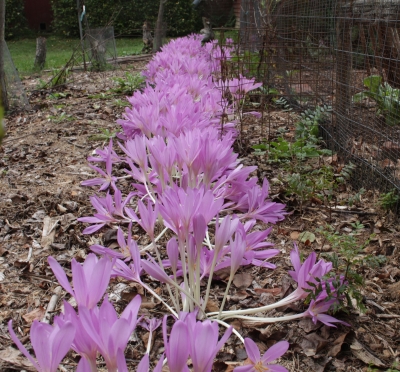
Cochicums, like every other plant, need to photosynthesize, and, like every other plant, need leaves to do so. Those leaves, which are wide, long, and fairly large, appear for awhile in spring and look nothing like true crocus leaves. Not only do the plants not need leaves in autumn, they also don’t need soil. Colchicum bulbs will sprout their lurid violet flowers even if just left sitting on a bench or table!
Green Tastes Good
Aside from spots of bright color, the dominant color in my garden is green. That verdure is especially evident in my vegetable garden, now in its autumn glory – lush and green – and becoming more so every day. I’ve been sowing and planting with almost the same fervor as in spring.

Bed of lettuce and chinese cabbage
A few weeks ago I made my last planting of outdoor lettuce, using transplants that had been growing in seed flats for about a month. The varying textures and colors of the different varieties make a pretty tapestry on the ground, so pretty that it seems almost a shame to pick any of the tender, tasty heads and ruin the picture. I’m not sure how large they’ll grow before stopped or turned to mush by really cold weather. Protection beneath a tunnel of clear plastic with, later, an additional covering of some spun-bonded row cover material, should keep them and me happy into December.
Other beds display yet more shades of green with varying textures. There’s a bed of kale, which has been pumping out deep green leaves for good eating since spring. Another bed has endive – Broad-Leaved Batavian — planted close enough so neighboring plants push each other’s leaves over the loosely forming heads. Shaded from sunlight, those inner leaves become tender and sweet, livened up with just a hint of bitterness.
Green, Not for Eating
Lushest green of all beds in my garden are those that are sprouting oats. Yes, that’s the same oats that we (and horses) eat, except that I didn’t plant these oats for eating. I plant oats as so-called cover crops, which are plants grown to improve and protect the soil.
I can only eat just so much lettuce, endive, kale, and other greens. If I’ve filled this quota for planting and no longer have further use for every bed this season, I plant it with oats. September 30th is my deadline because after this date — here in the lower Hudson Valley, at least — days are too short and weather becomes too cold to expect much growth.
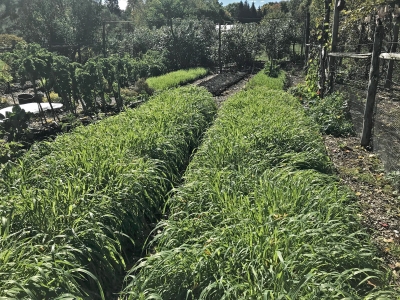
Oats, just one of a number of potential cover crops, thrive in the cool weather of autumn and early winter. Their roots, pushing through the soil, crumble it and latch onto nutrients that might otherwise wash down below the root zone. After the roots die, they enrich the soil with humus and leave behind channels through which air and water can move within the soil. Above ground, the stems and leaves protect the soil surface from being washed around by pounding raindrops.
Most of all, I like the look of that green carpet of grassy oat leaves. Both I and Mother Nature abhor bare ground, which becomes subject to wind and water erosion, and large swings in temperatures through the year.
GOOD LOOKS, GOOD TASTES
/4 Comments/in Flowers, Vegetables/by Lee ReichKale’s Delights
I’m lucky enough to have a French window of two big, inward swinging panels out of which I can look over my vegetable garden every morning. Oddly enough, the garden bed that is catching my eyes these mornings for its beauty is the bed of kale plants.
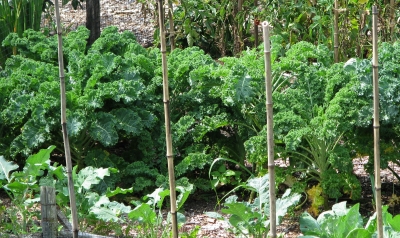
No, it’s not a bed of one of the so-called colorful, ornamental kales, not even a reddish kale such as Russian Red. I mostly grow just plain old Blue Curled Scotch kale, which is no more bluish than any other kale, or any other member of the whole cabbage family for that matter. What catches my eye each morning is the frilliness of the leaves and how neatly they line up along the stalk. It’s pretty.
My vision could be swayed by the fact that kale is such a healthful vegetable, being especially rich in calcium and vitamin A. Or the fact that it’s so easy to grow. I sowed the seeds in March, put out transplants in early May, have been harvesting it since the end of May, and will continue to do so probably well into December. (Another bed of kale, which I seeded right out in the ground at the end of May, is also looking good.)
Kale is unlike other members of the cabbage family. Broccoli is past its prime once buds open into flowers. Cauliflower is over the hill once the florets sidle apart from each other. Cabbage splits if left too long. Brussels sprouts needs sowing in early spring but aren’t ready for eating until touched by frost at the other end of the growing season.
Kale doesn’t have a small window of time for optimum harvest; actually, no window. It just keeps growing taller, with more leaves, still tasting good at all stages.
The only thing kale needs protection from is rabbits and woodchucks, like most vegetables, and from the various cabbage worms. One or two sprays of the biological pesticide Bacillus thurengiensis (sold under such trade names as Thuricide and Dipel) is all that’s needed for the worms, or nothing, especially in a year like this when worms were pretty much absent.
What more could I ask for from a plant: flavor, health, and beauty?
Free Kisses
I take it upon myself to personally promote the revival of an old-fashioned flower: kiss-me-over-the-garden-gate (Polygonum orientale). It’s big, it’s beautiful, and it’s distinctly old-fashioned.
If you know the weed called smartweed, you have a hint of what kiss-me-over-the-garden-gate looks like. Smartweed is a trailing weed whose flowers look like small droplets of pink dew at the ends of its stems. Kiss-me-over-the-garden-gate looks like smartweed on steroids, with “droplets” the size of bb’s. Rather than trailing, the plant rises with robust arching stems to more than seven feet high. It’s just the height and form for growing next to a garden gate, which is where my plants grow.
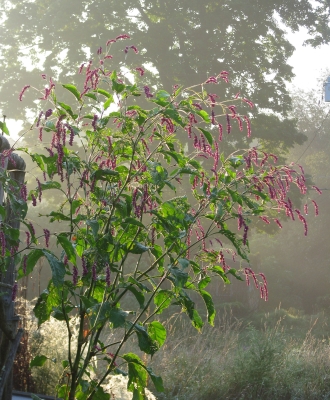
Kiss-me-over-the-garden-gate is a little hard to get started because the seeds germinate slowly and erratically. My plants thankfully lived up to their reputation of being self-seeding annuals, and those self-seeding plants come up more robustly than the few coddled seedlings I used to plant out each spring.
It’s self-seeding habit is sufficiently restrained for me. All I do each spring now is to weed out the few extra plants, as well as those that stray too far from the garden gate.
Ever Green Onions
For many years, in addition to starting onions from seed (sown in February!), I also went the more conventional route and bought a few “sets” for planting. Sets are those small bulbs that grow first to become scallions, which are mostly leaf, then go on to fatten into bulbs that can be harvested and stored.

This year, instead of planting sets for scallions, I grew bunching onions, yet another type of onion, one that never ever makes fat bulbs. During the growing season, slender new scallions are produced around the bases of older ones. Left outdoors, they will perennialize and multiply by offsets year after year.
I set out transplants back in early summer grown from seeds sown in spring. Even now, these scallions still look like scallions, some larger, some smaller, depending on how crowded they are to each other. No matter their size, they’ve all been flavorful right through summer and on into fall, maintaining all the time their scallion character.

